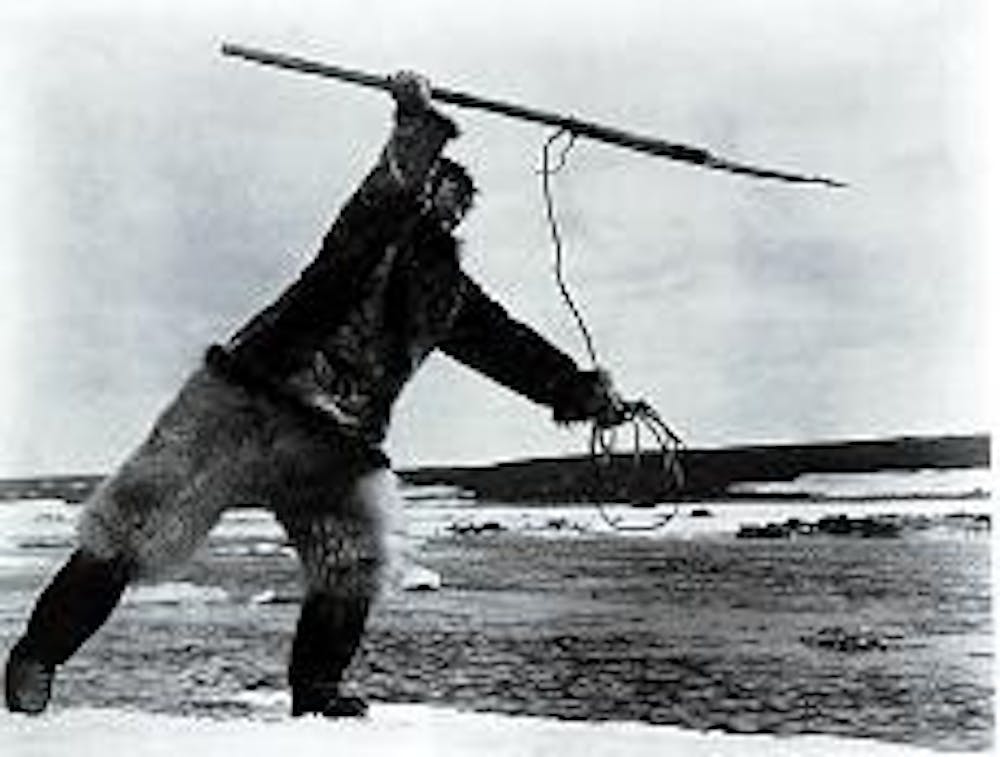Classic Flicks: Flaherty's Nanook of the North

Forget Bear Gryllis - It's real-life man versus wild in Robert Flaherty's documentary Nanook of the North
How often does the first of anything stand the test of time? We don't see too many people driving around in Model-T's these days, nor do we see anyone carrying textbook-sized cell phones except in 20-year-old films. American director Robert Flaherty's silent documentary, Nanook of the North, the first nonfiction feature of its kind, remains surprisingly fresh today, nearly 90 years after its release.Flaherty is not a household name, but if you have ever seen a documentary, you have seen one of his great-grandchildren. Filmmakers of old and of new have long sung the praises of Flaherty's films: Nanook of the North was a favorite of Orson Welles, and contemporary director Ramin Bahrani (Chop Shop, Man Push Cart) said the film "is a visual poem that challenges how we live and how we see, and all the while accepting life for what it is."
The title hero is an Inuit hunter who courageously leads his young son, a 4-month-old infant, his two wives and a pack of dogs through the frigid Canadian Arctic. But what do they do? There is no weeping or wailing. Instead, the family smiles and remains steadfast. The children ride sleds. These are a people intimate with la joie de vivre. A director today might handle Flaherty's material quite differently - taking the harsh Arctic weather as an inspiration and having a few of Nanook's dogs or children die on the way - however, none of that is present in Flaherty's film. Yet sadly, in a stroke of cruel irony, Nanook succumbed to tuberculosis two years after the film's release.
Flaherty's method of storytelling is straightforward, as he portrays trials of man in the hands of nature. Funded by French fur company Revillon Freres, Flaherty shot his film from August 1920 to August 1921 near the Ungava Peninsula of Hudson Bay, located in Arctic Quebec. He was able to develop and print his film in situ, sometimes screening his footage for an audience of curious Inuits. Despite technical limitations, Flaherty managed to make activities which are mundane to the Inuits, such as seal and walrus hunting or igloo building, seem thrilling yet familiar to the viewer. The film is timeless - it's not difficult to imagine a present-day Inuit patriarch facing the same challenges as Nanook did decades ago.
Other brilliant titles by Flaherty include Man of Aran (1934) and Louisiana Story (1948). A DVD version of Nanook of the North is available at Fondren Library, but if you feel that you must watch the film right away, you are in luck - Nanook of the North is in the public domain, so here's one film you can legally stream from the Internet (try www.archive.org) and watch on your computer.
Flaherty has been criticized for staging the events on screen, a fact he never hid - if you pay attention to the opening credits, you'll note that Flaherty was credited as the film's writer. Werner Herzog, whose documentaries also rank among the most engaging ever produced, is also known to stage events. But the staged action in Nanook of the North is as real as it gets: When Nanook is hunting a seal, there are no gimmicks or special effects involved - he is really hunting a seal. All of Shakespeare's works were fiction or fictionalized versions of history, yet the Bard is still counted among the greatest authors of all time. Likewise, if Flaherty's images work, does it really matter whether or not they were staged? Flaherty himself said, "Sometimes you have to lie. One often has to distort a thing to catch its true spirit." Staged or not, Flaherty forcefully documents the reality of what it is to be human.
Clocking in at merely 79 minutes, Nanook of the North is no Birth of a Nation. Whether the only silent film you have seen was an accidentally muted YouTube video or you are a Chaplin nut, you must set aside an hour and watch this film. Nanook of the North is a testament to a way of life - and life itself - which, for the most part, has changed very little for many of our boreal neighbors.
More from The Rice Thresher

Scott Abell named football head coach
Rice football has hired Scott Abell as the program’s 20th head coach, according to an announcement from director of athletics Tommy McClelland, who led a national search to fill the position.

Local Foods launches in newly renovated Brochstein space
Local Foods Market opened at Brochstein Pavilion Nov. 19, replacing comfort food concept Little Kitchen HTX. The opening, previously scheduled for the end of September, also features interior renovations to Brochstein. Local Foods is open from 8 a.m. to 6 p.m. on weekdays and 9 a.m. to 5 p.m. on weekends.

Scan, swipe — sorry
Students may need to swipe their Rice IDs through scanners before entering future public parties, said dean of undergraduates Bridget Gorman. This possible policy change is not finalized, but in discussion among student activities and crisis management teams.

Please note All comments are eligible for publication by The Rice Thresher.